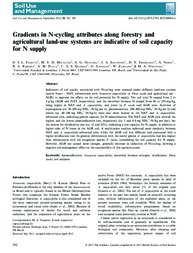Gradients in N-cycling attributes along forestry and agricultural land-use systems are indicative of soil capacity for N supply.
Gradients in N-cycling attributes along forestry and agricultural land-use systems are indicative of soil capacity for N supply.
Autoria: FAGOTTI, D. S. L.; MIYAUCHI, M. Y. H.; OLIVEIRA, A. G.; SANTINONI, I. A.; EBERHARDT, D. N.; NIMTZ, A.; RIBEIRO, R. A.; PAULA, A. M.; QUEIROZ, C. A. S.; ANDRADE, G.; ZANGARO, W.; NOGUEIRA, M. A.
Resumo: Indicators of soil quality associated with N-cycling were assessed under different land-use systems (native forest ? NAT, reforestation with Araucaria angustifolia or Pinus taeda and agricultural use ? AGR) to appraise the effects on the soil potential for N supply. The soil total N ranged from 2 to 4g⁄ kg (AGR and NAT, respectively), and the microbial biomass N ranged from 80 to 250 mg⁄ kg, being higher in NAT and A. angustifolia, and lower in P. taeda and AGR sites. Activities of asparaginase (ca. 50?200 mg NH 4 + -N ⁄ kg per h), glutaminase (ca. 200?800 mg NH -N ⁄ kg per h) and urease (ca. 80?200 mg NH -N ⁄ kg ⁄ h) were also more intense in the NAT and A. angustifoliareforested soils, indicating greater capacity for N mineralization. The NAT and AGR soils showed the highest and the lowest ammonification rate, respectively (ca. 1 and 0.4 mg NH 4 + -N ⁄ kg per day), but the inverse for nitrification rate (ca. 12 and 26%), indicating a low capacity for N supply, in addition to higher risks of N losses in the AGR soil. A multivariate analysis indicated more similarity between NAT and A. angustifolia-reforested sites, whilst the AGR soil was different and associated with a higher nitrification rate. In general, reforestation with the native species A. angustifolia had less impact than reforestation with the exogenous species P. taeda, considering the soil capacity for N supply. However, AGR use caused more changes, generally decrease in indicators of N-cycling, showing a negative soil management effect on the sustainability of this agroecosystem.
Ano de publicação: 2012
Tipo de publicação: Artigo de periódico
Unidade: Embrapa Soja
Palavras-chave: Ammonification, Amonificação, Nitrification, Nitrificação, Qualidade, Soil quality, Solo
Observações
1 - Por padrão são exibidas publicações dos últimos 20 anos. Para encontrar publicações mais antigas, configure o filtro ano de publicação, colocando o ano a partir do qual você deseja encontrar publicações. O filtro está na coluna da esquerda na busca acima.
2 - Para ler algumas publicações da Embrapa (apenas as que estão em formato ePub), é necessário ter, no celular ou computador, um desses softwares gratuitos. Sistemas Android: Google Play Livros; IOS: iBooks; Windows e Linux: software Calibre.
Acesse outras publicações
Acesse a Base de Dados da Pesquisa Agropecuária (BDPA) para consultar o acervo completo das bibliotecas da Embrapa.

